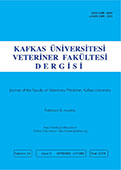
This journal is licensed under a Creative Commons Attribution-NonCommercial 4.0 International License
Kafkas Üniversitesi Veteriner Fakültesi Dergisi
2018 , Vol 24 , Issue 5
Differential Expression of Proteins in Datong Yak and Chaidamu Yellow Cattle Longissimus Lumborum Muscles and Relation to Meat Water Holding Capacity
1State Key Laboratory of Plateau Ecology and Agriculture, Qinghai University, Xining, Qinghai, 810016, PR CHINA2Agriculture and Animal Husbandry College of Qinghai University, Xining, Qinghai, 810016, PR CHINA
3School of Biological Sciences, University of Auckland, Private Bag 92019, Auckland 1010, NEW ZEALAND DOI : 10.9775/kvfd.2018.19734 We investigated that proteins differently expressed in Datong Yak and Chaidamu Yellow Cattle longissimus longurum muscles and their relation to tissue water-holding capacity (WHC). Samples were classified according to breed and postmortem aging into Yak0h, Cattle0h, Yak24h and Cattle24h groups. Fifty seven differentially expressed proteins were confirmed by MALDI-TOF/TOF-MS. Twenty eight proteins could be identified and were divided into five main categories: structural proteins, metabolic enzymes, stress related proteins, transporter proteins and binding proteins. Myosin light chain (MLC), Heat Shock 27kDa (HSP 27) and Keratin 10 (KRT 10) proteins showed significant differences in expression between yak and cattle meat and may have the potential to be used as biological markers of tissue WHC. Bioinformatics analysis showed differentially these proteins included both metabolic enzymes and structural proteins. The functions of the identified proteins contribute to a more detailed molecular view of the processes behind WHC and are a valuable resource for future investigations. Keywords : Bos taurus, LL muscles, WHC, Meat quality, Proteomics, Bioinformatics










